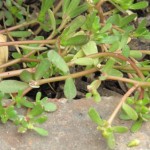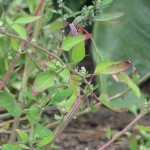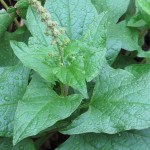 |
 |
 |
The edible weeds that grew among the cultivated vegetables in the medieval kitchen garden were also harvested and used as potherbs. Above, from left to right: purslane, a succulent weed of fertile soils, is a common weed in our own vegetable gardens; lamb’s quarters, also known as “fat hen,” is now a very common weed in the United States; Good King Henry is related to the nutritious lamb’s quarters and was cultivated as a vegetable. Photographs by Corey Eilhardt.
A weed is a plant you don’t want. An herb is a plant with a use. But many of the “weedy” species that are considered garden nuisances today were actually valued in the Middle Ages. Edible weeds growing in the kitchen garden, along with the cultivated vegetables, were used in pottage, a basic medieval dish. (For more on pottage, see last week’s post, “Colewort and Kale.”) Although medieval gardeners took means to eliminate weeds within field crops like wheat, when they dug up cabbages and leeks, they also harvested the edible weeds growing nearby and boiled everything together in the same pot. Some of the edible weeds commonly included in the resulting pottage??were purslane (Portulaca oleracea), lamb’s quarters (Chenopodium album), Good King Henry (Chenopodium bonus-henricus), dandelion (Taraxacum officinale), chickweed (Stellaria media), and ribwort plantain (Plantago lanceolata). (For more information on pottage plants, refer to Dr. Sylvia Landsberg’s index of plants, published in Medieval Gardens (pp. 142???143).
At The Cloisters, in the pottage and culinary beds of Bonnefont garden, there are several edible weeds growing among the vegetables. Purslane is an annual in the Portulacaceae family that originated in the Near East or Central Asia. Its small, succulent leaves, stems, and flower buds can be eaten cooked or raw. The leaves and young shoots can be used in a salad, while the older shoots can be used as a potherb, and the thicker shoots can be pickled. Even though purslane can tolerate poor, compacted soils, it thrives on the rich, fertile soil in our pottage bed.
Lamb’s quarters grows nearby. (An alternate name for this plant is “fat hen,” because it used to be fed to poultry in order to fatten them.) A highly nutritious plant of rapid growth, lamb’s quarters thrives in very rich soils and compost heaps. Its leaves can be cooked similarly to the way spinach is cooked, and the seeds can be used to produce dark-colored bread products that taste similar to buckwheat.
Good King Henry, which is in the same genus as lamb’s quarters, can also be found growing in Bonnefont garden. (The genus Chenopodium includes many edible plants, including the currently popular quinoa, known for its seeds.) In the Middle Ages, Good King Henry was grown as a potherb and was usually eaten in the spring and early summer. Its luscious green foliage was usually boiled or baked. Its small yellowish-green flower spikes were also edible, and the young shoots could be eaten in the same way as asparagus.
Medieval gardeners also used edible weeds for medicinal purposes. The juice of purslane, for example, was believed to soothe coughing and breathing problems, as well inflammation and irritation of the skin. Good King Henry’s leaves were used to produce an ointment for cleansing chronic sores.
???Corey Eilhardt
Sources:
Davidson, Alan. The Oxford Companion to Food. Oxford: Oxford University Press, 1999.
Harvey, John. Medieval Gardens. Beaverton, Oregon: Timber Press, 1981.
Jones, Pamela. Just Weeds: History, Myths, and Uses. Illustrations by Bob Johnson. New York: Prentice Hall, 1991.
Landsberg, Sylvia. Medieval Gardens. London: Thames & Hudson, 1996.
Tags: cabbage, Chenopodium album, Chenopodium bonus-henricus, dandelion, Good King Henry, herb, kale, lamb's quarters, leek, Portulaca oleracea, pottage, purslane, ribwort plantain, weed

October 29, 2010 at 3:21 pm
This is a great blog. Wish it wasn’t so hard to find, though. It would be terrific if a link could be put on The Cloisters Museum home page.
October 29, 2010 at 4:18 pm
Soretta, thanks for the compliment! We’re all thrilled with the kind words.
Ironically, we actually do have a link to the blog from the main Cloisters page, at
http://www.metmuseum.org/cloisters/
but that’s not to say the blog is easy to find! We know our website is too hard to use and we’re rebuilding it now with a particular eye to much more usable navigation. It’s a big site and a complicated job, but when we launch I hope you’ll find it much easier to get around.
Thanks,
Matt Morgan
General Manager of the Website
The Metropolitan Museum of Art
October 31, 2010 at 2:54 pm
Thanks very much for this post, it gives me some much-needed context on a paper I once read by a chap called Peter Reynolds, another historic grower, about edible weeds’ use in the Middle Ages. Not many economic historians bother with this sort of thing, yet “what did they eat?” seems a fairly fundamental part of knowing any culture to me.
August 18, 2011 at 9:01 pm
I very much enjoyed this post. I have just recently discovered purslane as a vegetable and I love it.